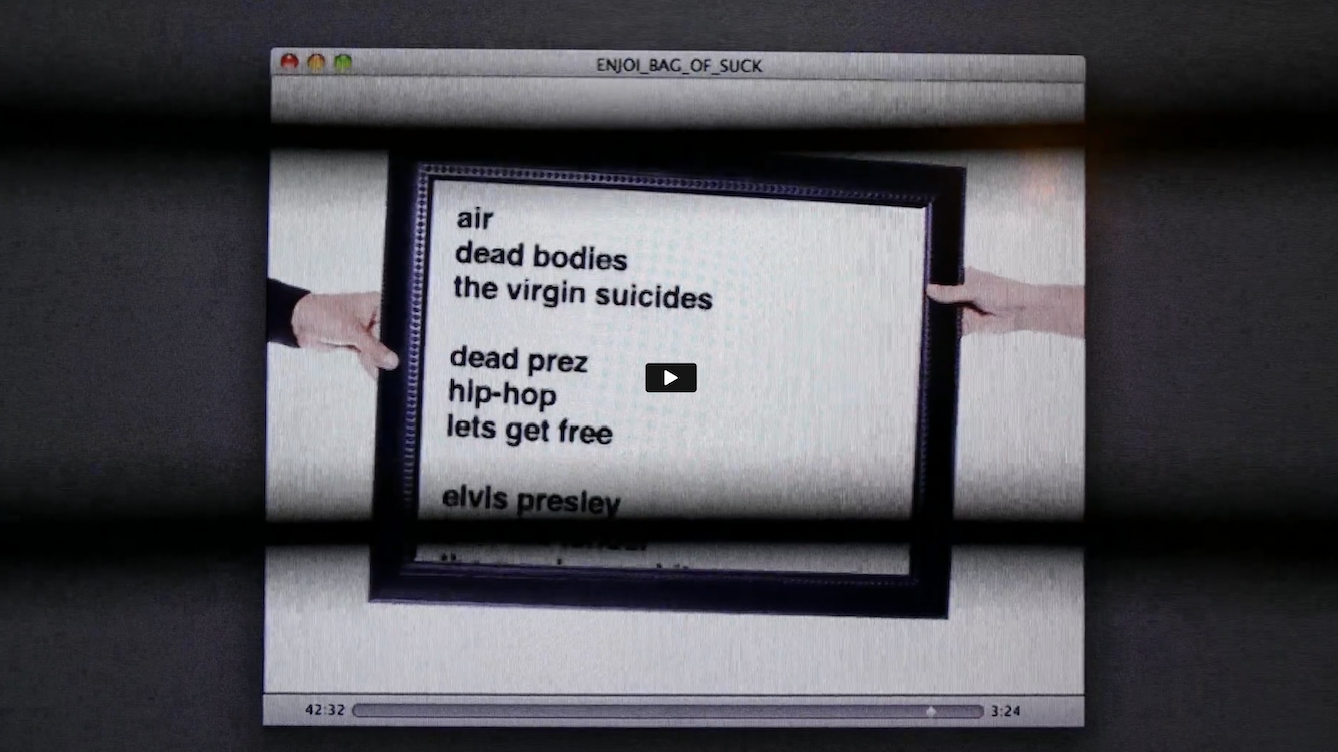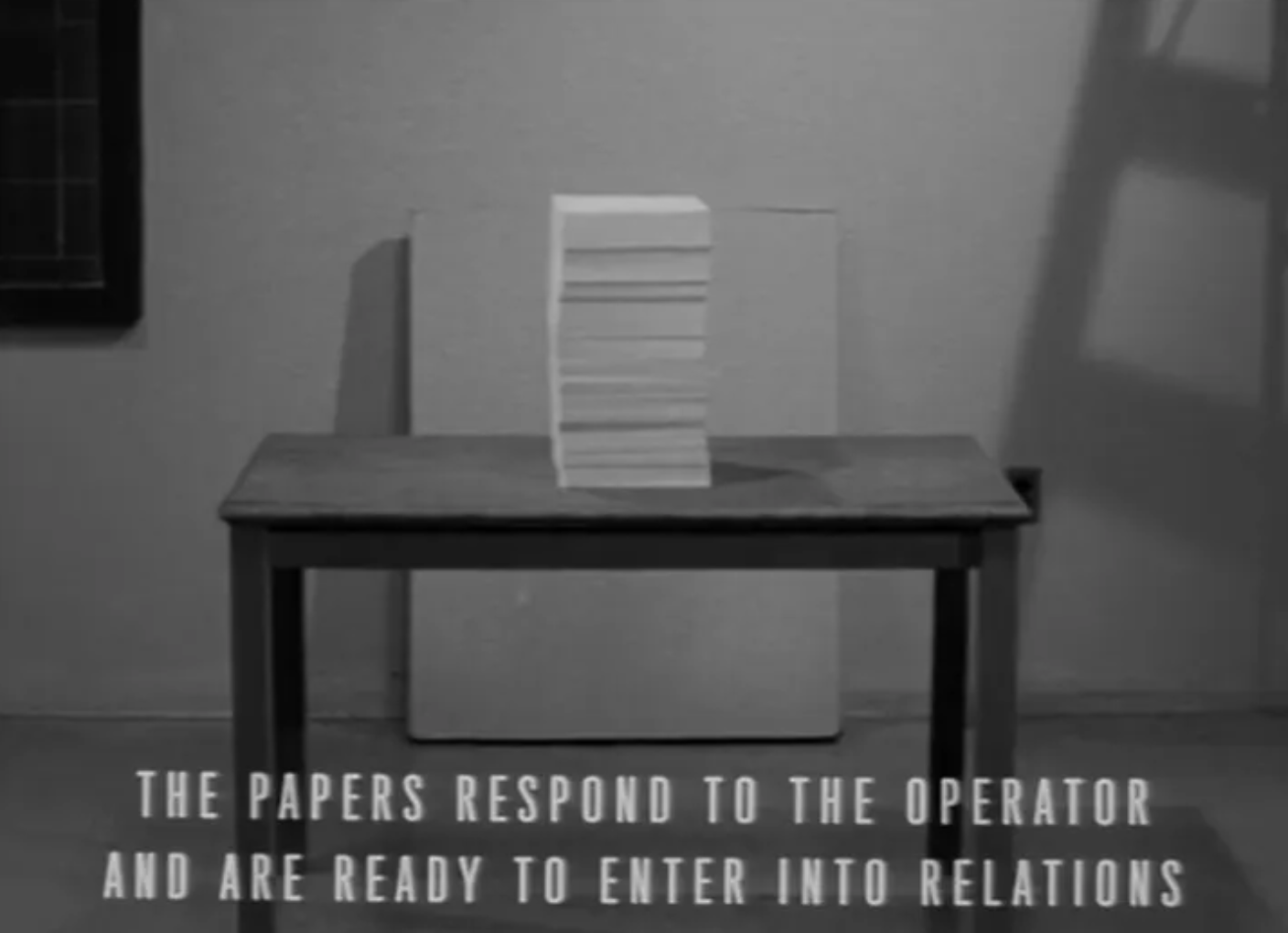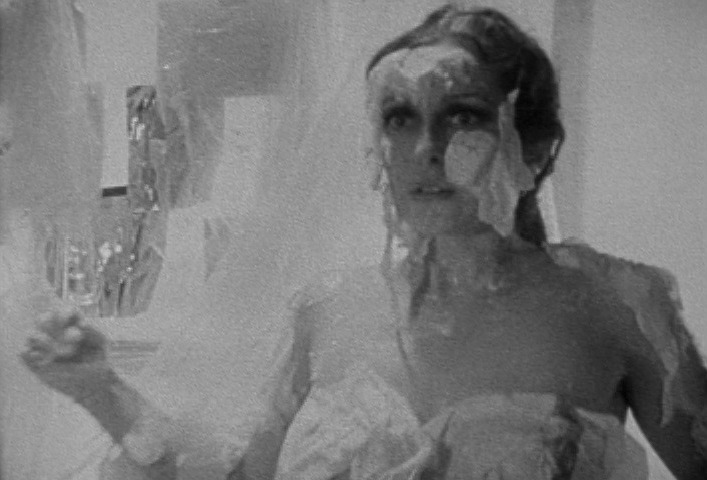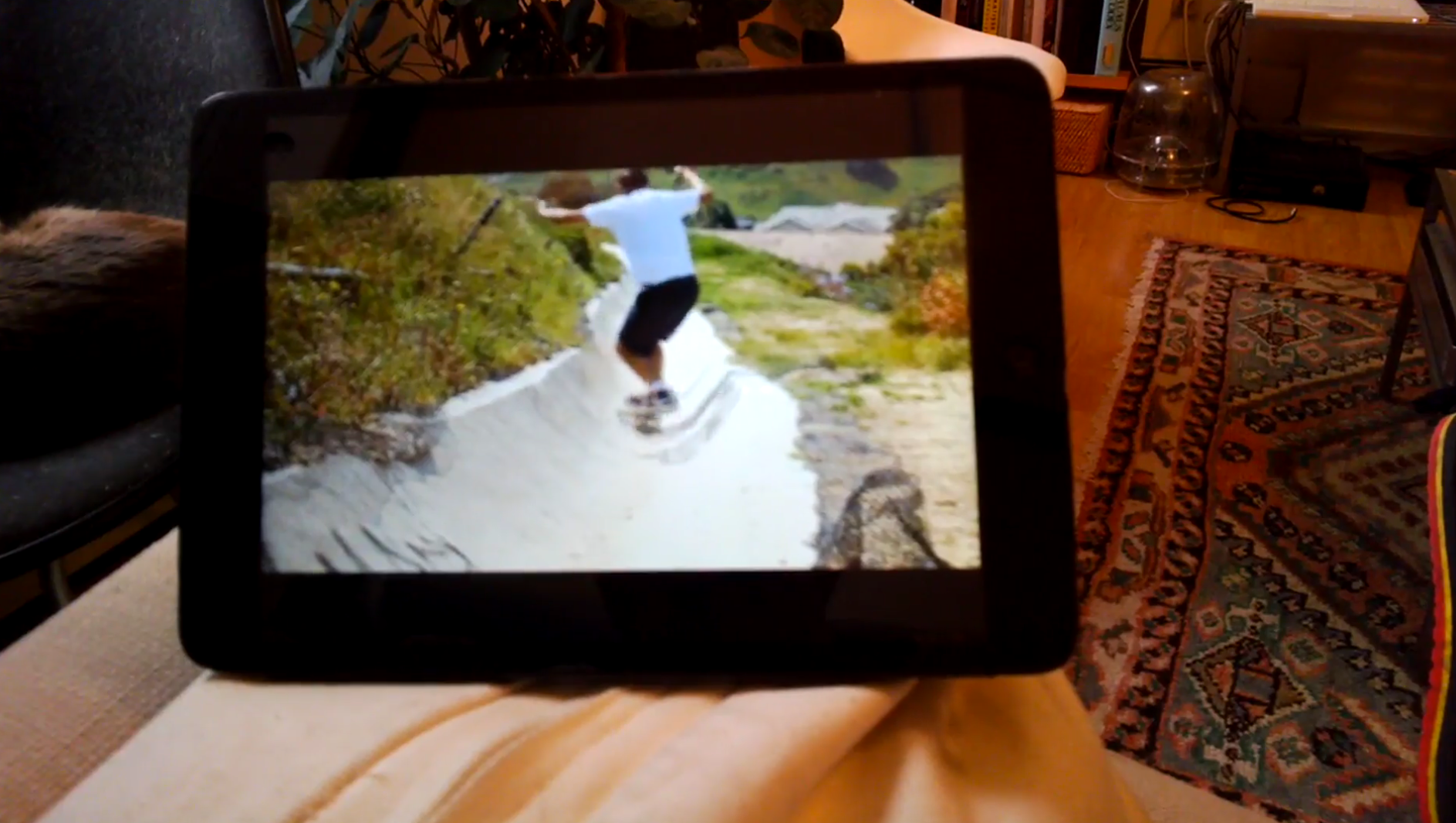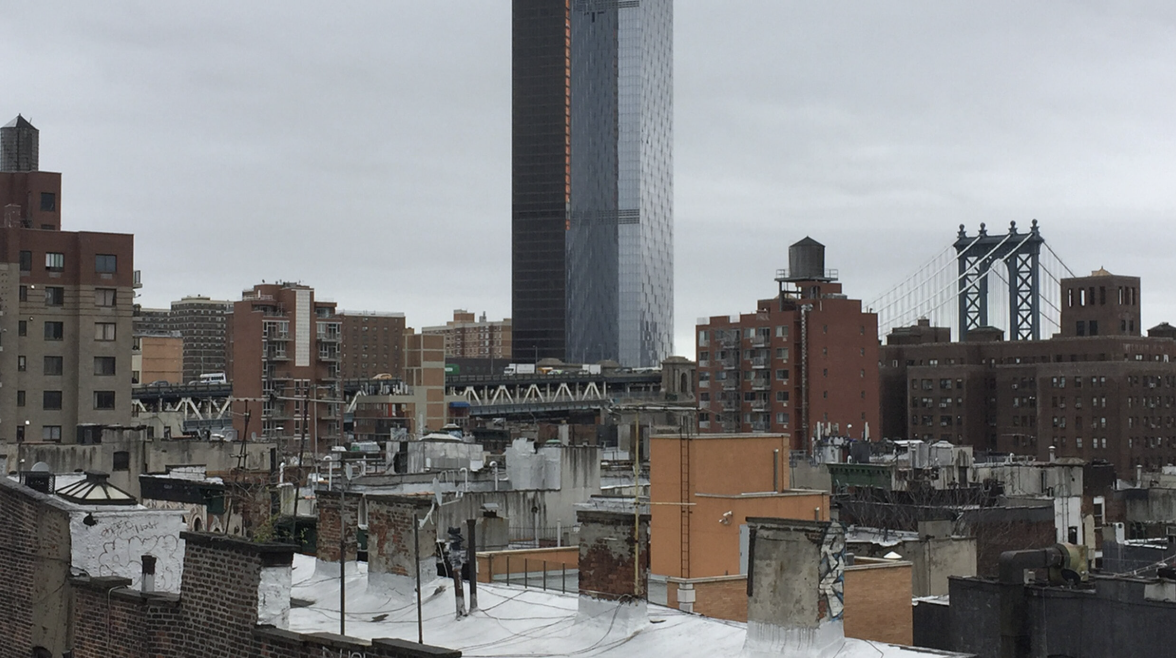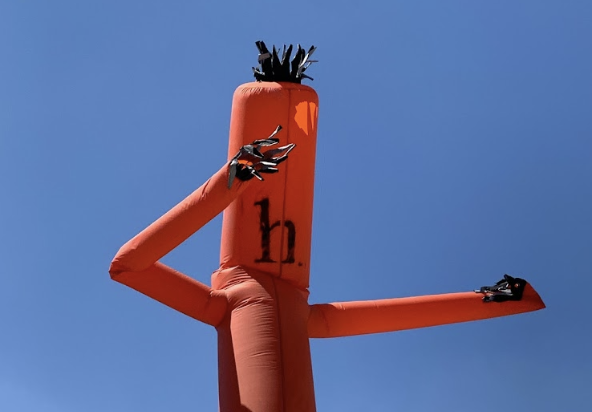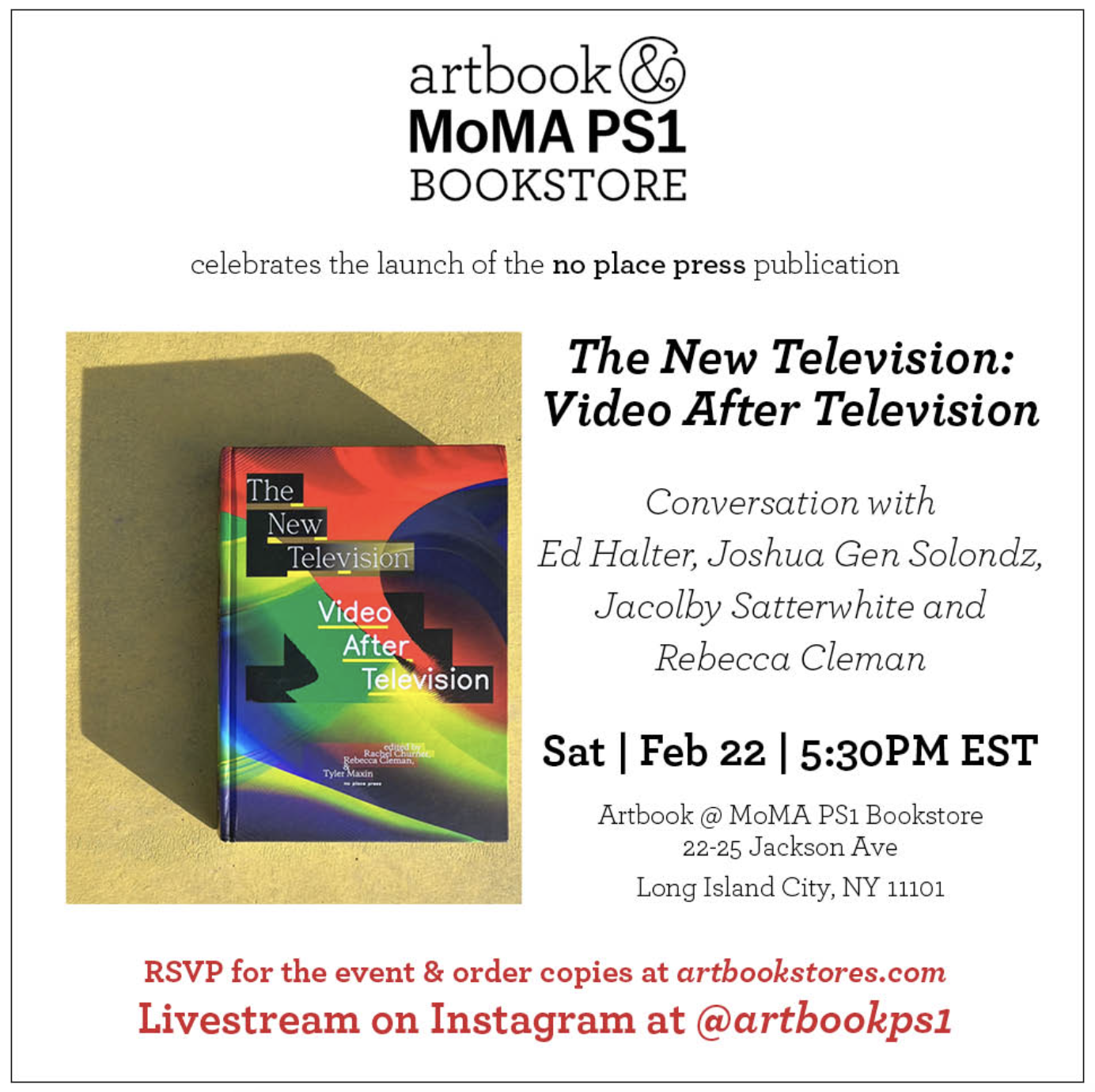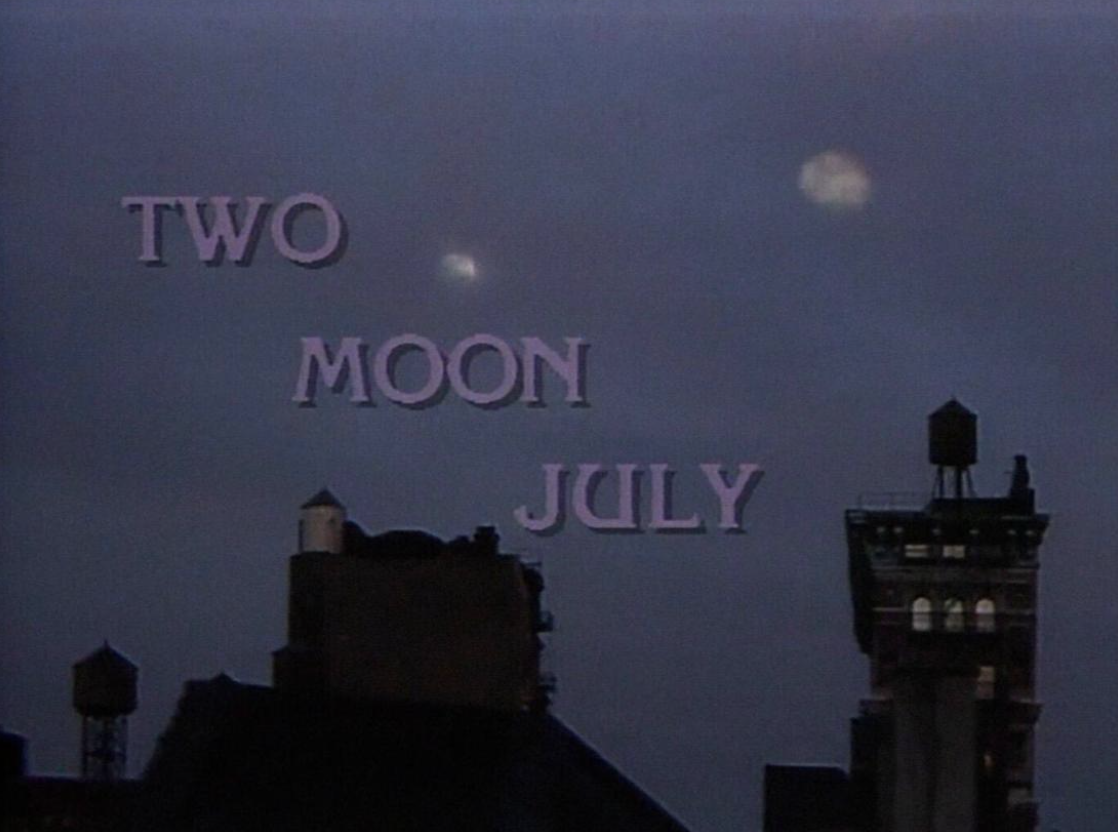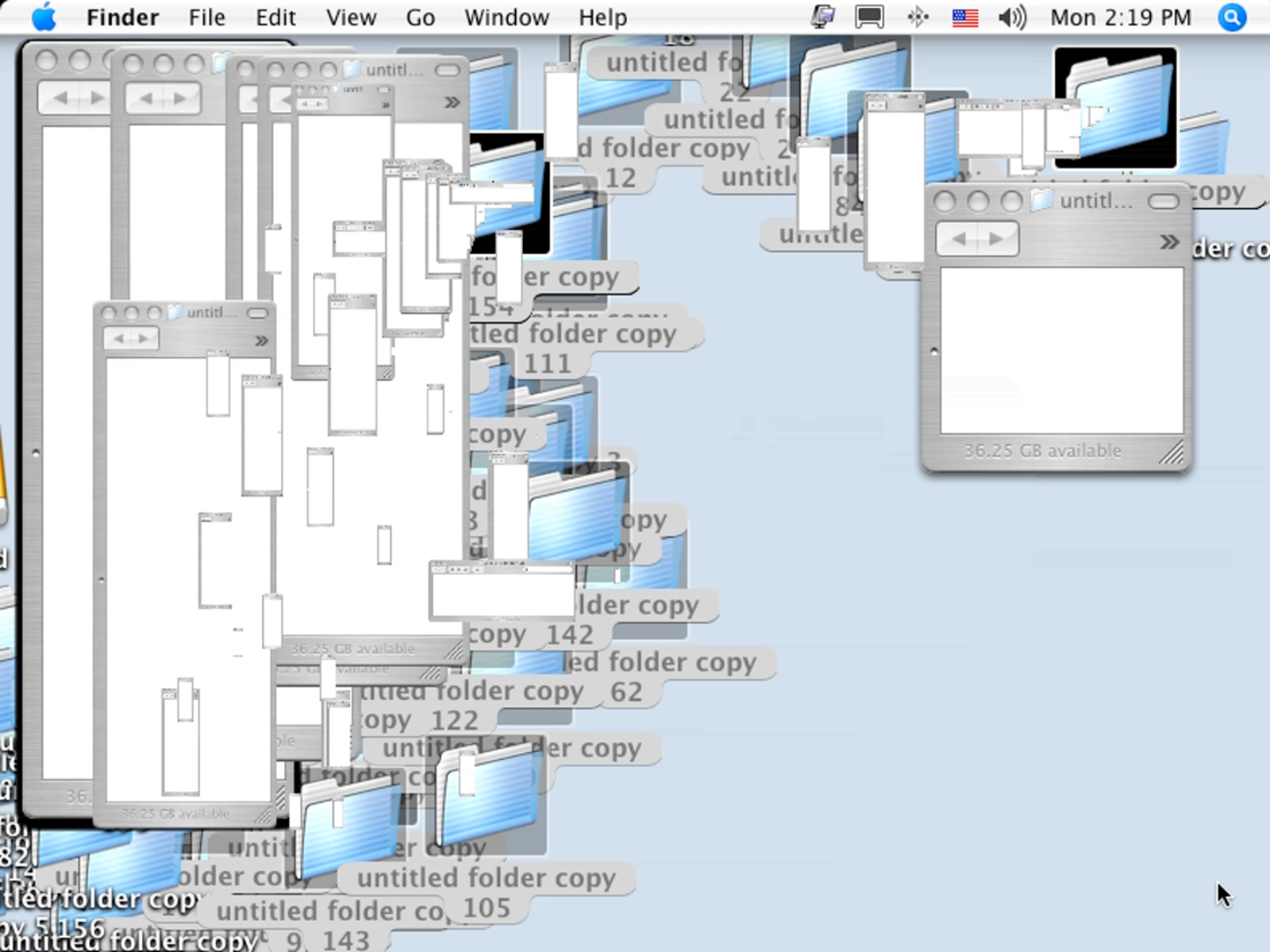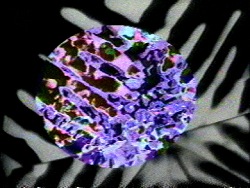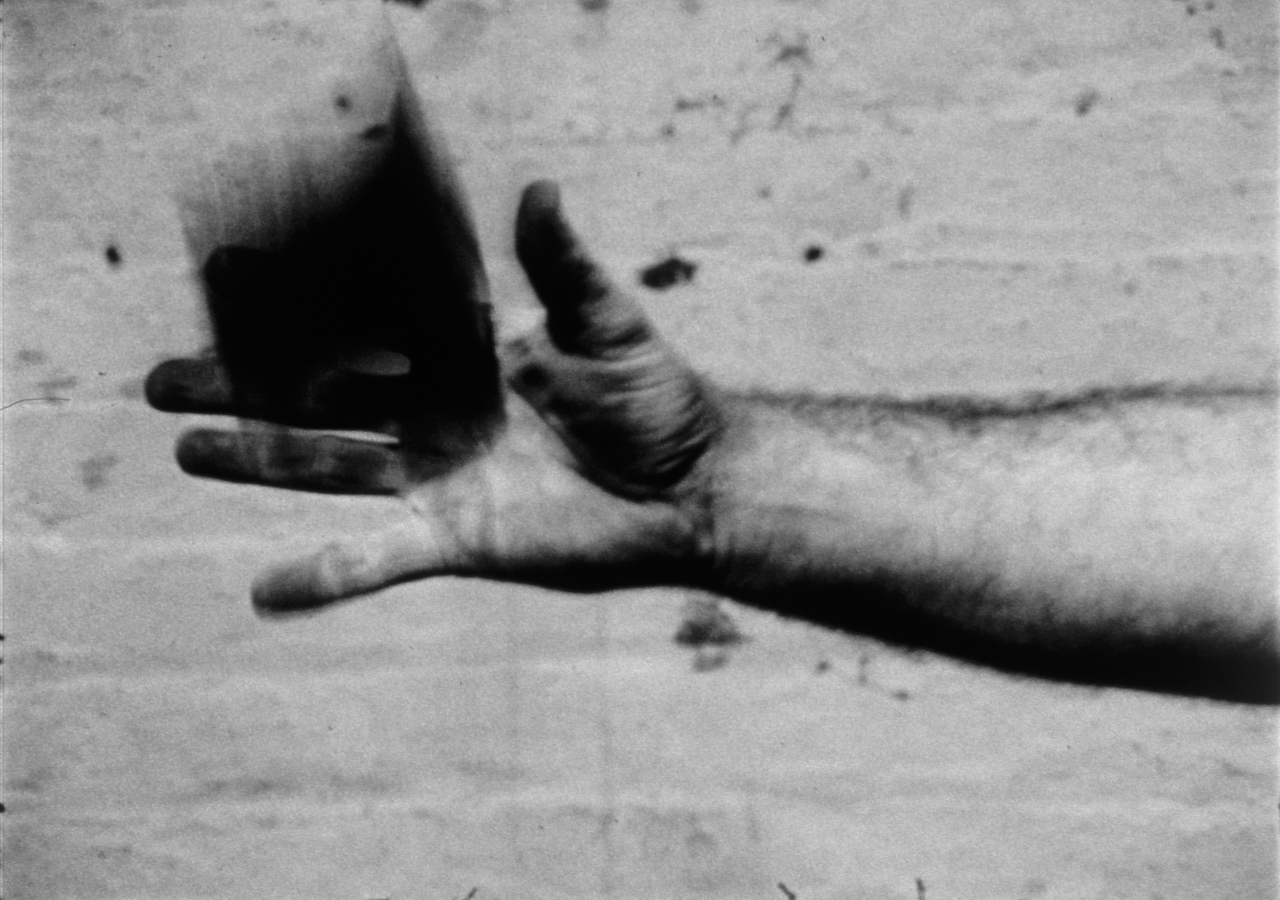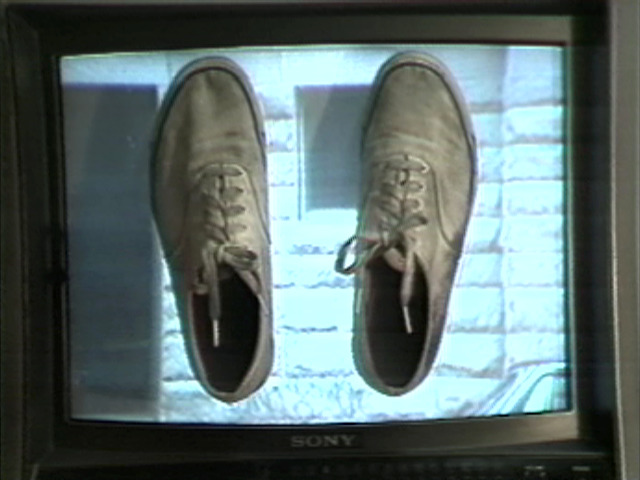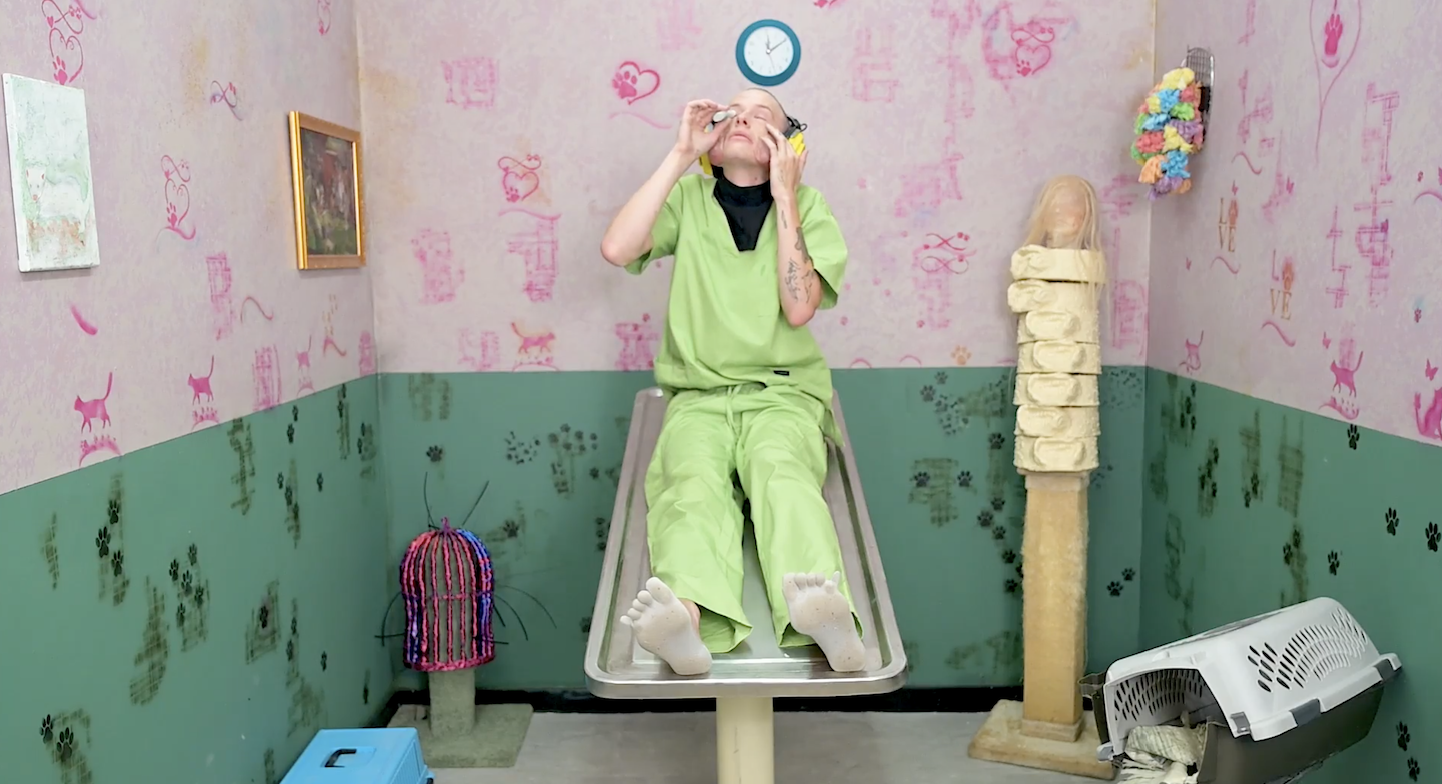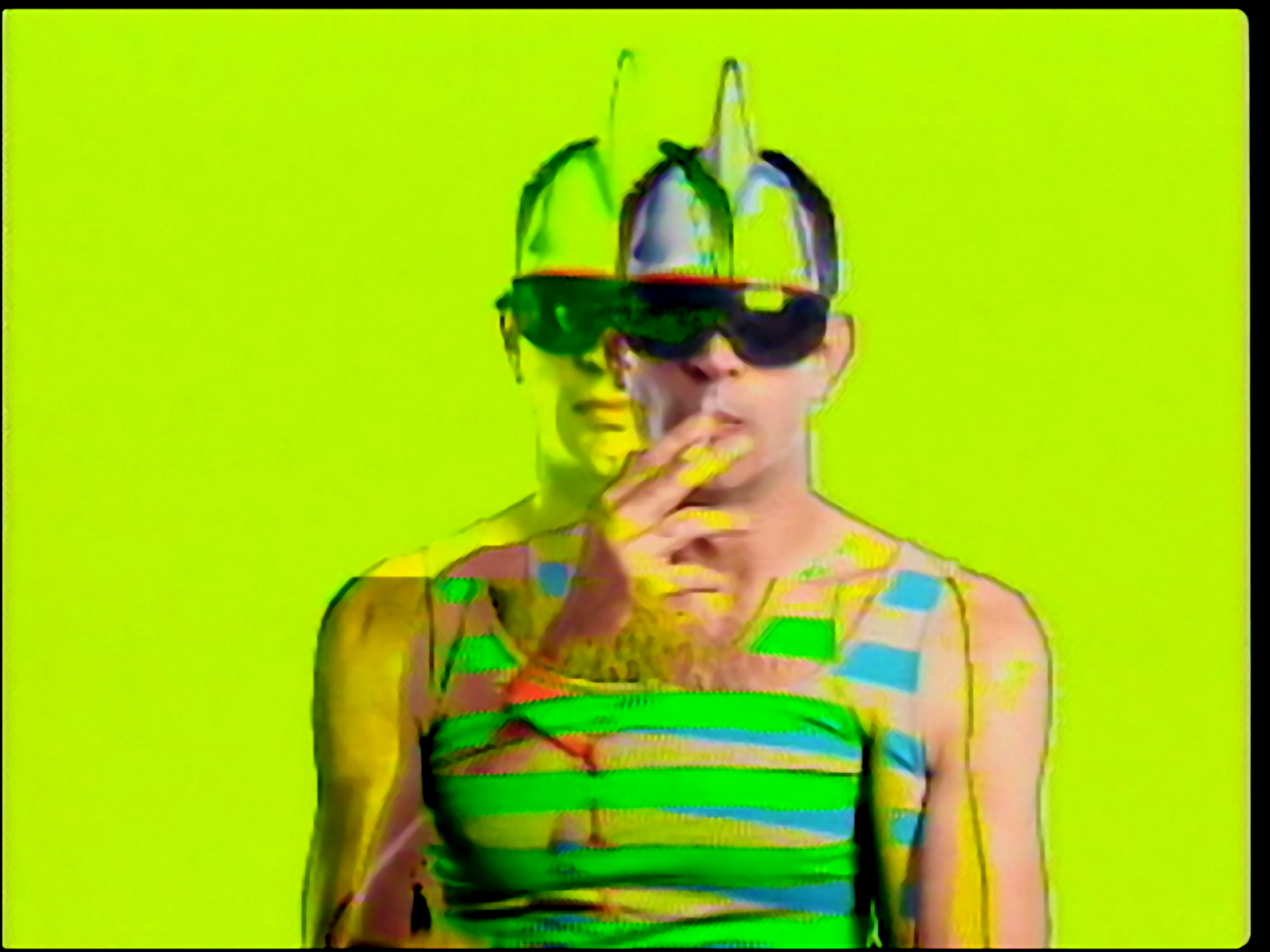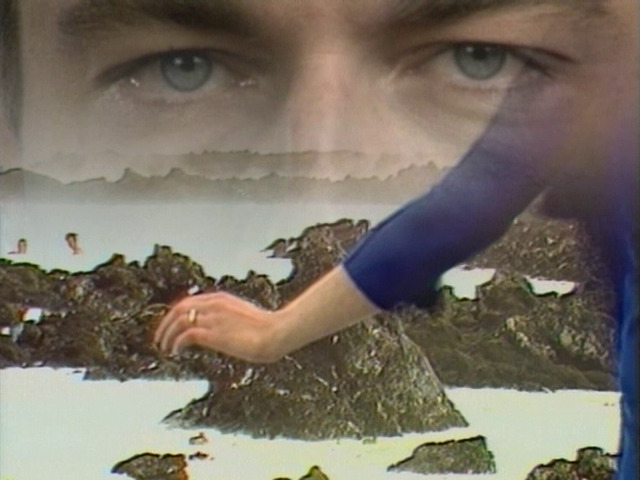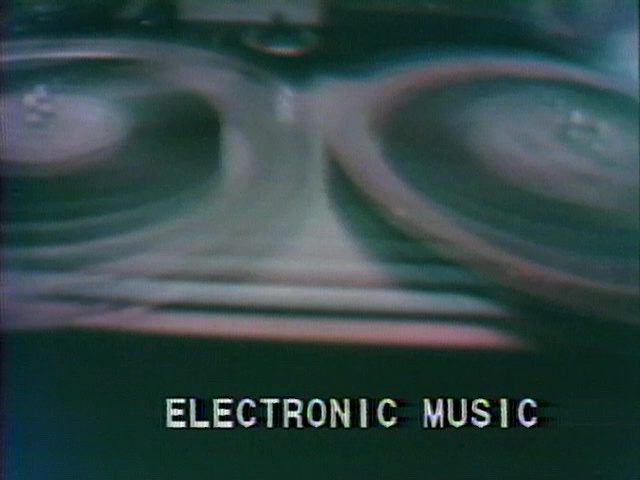Events
Events
Past Events
An Evening with Trevor Shimizu (Online)
Electronic Arts Intermix (EAI)
trevorshimizu.eai.org
December 1st to December 14th, 2025
This online presentation of videos by Trevor Shimizu stems from the artist’s 2013 video series, The Lonely Loser Trilogy. On October 2, 2025, EAI invited the artist to transform our office into a dynamic environment for video and socializing. The event was held in tandem with Shimizu’s solo painting exhibition and EAI’s residency at 47 Canal, which featured videos from Paul McCarthy, Carolee Schneemann, and Bruce Nauman, selected by the artist. This showcase will be available starting Monday, December 1, through December 19.
Shimizu presents a selection of short videos including The Lonely Loser Trilogy: Skate Videos. Shimizu frames the compilation through his evolving sense of physicality as an artist, skater, and eventually, parent. He contrasts the sedentary lifestyle of his younger years—including his tenure as Technical Director for EAI—with the balance, poise, and athleticism of inspirational figures including Nauman and the skateboarder Jerry Hsu. Clips showcasing Shimizu’s musical collaborations with Cass McCombs, re-recorded skate videos and advertisements for skating equipment, and Shimizu’s Google Glass footage highlight the fluid relationship between being a viewer and maker of art.
From Shimizu: “Sometime around 2003-2004, I recorded and toured with Cass McCombs. We recorded an album called PREfection. A few songs were used in some great skate videos. I was completely unaware of skateboarding at the time, having stopped about 10 years before. I came across Jerry Hsu’s part which features a song from the album and I was just completely blown away. Sometime around 2013, I bought the DVD on eBay, played it off a CRT monitor and used a 4K camera to record. I used to say that this was my greatest life achievement before getting married and having children.
While watching daytime television, I saw an advertisement for a remote controlled cylinder going around some obstacles at a skatepark. This came out around the time Google Glass came out. So I used the Google glasses to record my skate video browsing. I was thinking of skating more frequently again and saw these videos by the Welcome Skateboards team. They were really amazing and inventive, but also made me feel so old and as if I were Encino Man, waking up to the new world of skateboarding.
I remembered Mark Gonzalez from when I was a child and saw this clip of him skating many years later. After our daughter was born, I saw him as a role model—great skater, artist, and dad.”
Image: Music credits from Bag of Suck (2006) by Enjoi Skateboards.
Fundamental Motions: Recent Titles in Distribution
Electronic Arts Intermix (EAI)
264 Canal Street #3W
New York, NY 10013
December 11th, 2025
7:00 pm ET
RSVP here. Seating is first come, first serve. RSVP does not guarantee entry, but helps us track interest and send event updates and reminders.
Electronic Arts Intermix (EAI) presents a selection of works recently added to our distribution catalogue by Michael Bell-Smith and Sara Magenheimer, Zoe Beloff, Michael Smith, and Sophie Breer with David Wojnarowicz. The evening takes its title from Zoe Beloff’s The Infernal Dream (2011), which invokes Frank and Lillian Gilbreth’s time-motion studies aimed at maximizing workplace efficiency.
In this program, artists subvert systems of bodily control. Utilizing a range of ubiquitous communication formats including childrens’ television shows, Zoom calls, and industrial films, they highlight the absurdity of bureaucracy and technological optimization. Beloff’s single-channel piece—adapted from the artist’s 2011 installation, The Infernal Dream of Mutt and Jeff—reanimates two midcentury industrial films focused on maximizing productivity in the workplace through the visual language of slapstick, envisioning how metaphysically unruly objects can subvert capitalism's ideal of seamless labor protocols. Bell-Smith and Magenheimer's Acetone Reality (2025) uses computer-generated voices, animations, and found images to present a cascading meditation on the nature of meaning making. Breer’s Waje’s Cockabunnies (1981) showcases Wojnarowicz’s “cock-a-bunnies,” live cockroaches adorned with paper bunny ears and cotton tails, through the instructional format of the classic children’s television show Romper Room. Smith’s Zoom Room (2022) depicts Mike Smith, the artist’s Everyman alter-ego, as he attempts to lead a Zoom meeting with his less-than-enthusiastic staff.
An informal conversation with Beloff will follow the screening.
Electronic Arts Intermix (EAI)’s venue is located at 264 Canal Street, 3W, near several Canal Street subway stations. Our floor is accessible by elevator (63" × 60" car, 31" door) and stairway. Due to the age and other characteristics of the building, our bathrooms are not ADA-accessible, though several such bathrooms are located nearby. If you have questions about access, please contact cstrange@eai.org in advance of the event.
EAI at the Carriage Trade Book Fair
Carriage Trade
Grand St, 2nd Fl.
New York, NY 10002
November 14-16, 2025
EAI is pleased to participate in this year's Carriage Trade Book Fair. Browse a vibrant array of publications by EAI and our artists including EAI and no place press's 2024 release, The New Television: Video After Television—recently chosen by Alex Greenberger, Senior Editor of ARTnews, as one of his favorite art books of the year. We are also thrilled to offer Paul Ryan's Video Mind, Earth Mind, an out-of-print collection of texts by the artist addressing how video and television can respond to global ecological crisis, and limited copies of MIKE'S BOX, an immersive 8-disc compilation of Michael Smith's performance works complete with a richly illustrated booklet of original writing by Tim Griffin.
Book Fair Schedule
Friday, November 14: 6-8pm
Saturday, November 15: 1-8pm
Sunday, November 16, 1-6pm
Electronic Arts Intermix in residence at 47 Canal
47 Canal
59 Wooster Street, Second Floor
New York, NY 10012
Saturday, September 20, to Thursday, October 25
This residency is occurring in conjunction with Trevor Shimizu's solo painting exhibition at 47 Canal.
From Shimizu: The first three videos I watched from the EAI collection were Chris Marker’s Bestiaire (1985-1990), Michael Smith and William Wegman’s The World of Photography, (1986) and Alex Bag’s Untitled Fall 95 (1995). This was in 2005. My love for animals, pop culture, and humor are evident in my choices.
After a sledding injury in 2020, I visited a physical therapist. I’ve been trying to balance and strengthen my body ever since, but I’m often reminded that decades of bad posture and physical imbalance takes a lot of work to correct. This led to painting ambidextrously.
My therapist suggested that I perform my exercises “like a robot.” I’ve also incorporated this method into my painting, but my approach is irrational and unpredictable, depending on how my body wants to move. I’m doing this not as a conceptual gesture, but for practical and ergonomic reasons. What I’m attracted to in early video art has evolved as I have. The works selected for this viewing room relate to my more recent focus on the body, its limitations, potential, and how this applies to the process of painting.
Schedule:
Paul McCarthy
on view September 20th to October 1st
Carolee Schneemann
on view October 2nd to October 14th
Bruce Nauman
on view October 15th to October 25th
An Evening with Trevor Shimizu
Electronic Arts Intermix (EAI)
264 Canal St. #3W
New York, NY
10013
Thursday, October 2, 2025
7-9pm
RSVP here. Seating is first come, first serve. RSVP does not guarantee entry, but helps us track interest and send event updates and reminders.
Electronic Arts Intermix (EAI) is kicking off a new season of programming with a special presentation of video by Trevor Shimizu. This event is organized on the occasion of Shimizu's solo exhibition of new paintings and EAI’s residency at 47 Canal, on view September 20 - October 25.
EAI has invited the artist to transform our office into a dynamic social environment showcasing several videos, including Shimizu’s Lonely Loser Trilogy (2013). A featured screening of Lonely Loser Trilogy: Skate Videos (2013) will begin at 7:30PM, followed by a conversation with Shimizu and EAI’s Executive Director, Rebecca Cleman.
Shimizu's semi-autobiographical videos have explored the nature of self-representation from the position of distinct personas, much like his paintings, which have reflected the vantage of characters including a future elderly self, aspiring actor, and a suburban dad. Lonely Loser Trilogy: Skate Videos is shot from the perspective of a lonely corporate tech worker who takes an interest in extreme sports, an experience mediated by watching skate videos and equipment demos in the comfort of his apartment. The artist records extended browsing sessions online, underscoring Shimizu’s passive spectatorship. Skate Videos was recorded with an early model of the now-defunct Google Glass, further emphasizing the house-bound loser’s dependency on tech gear to compensate for inaction.
Shimizu started as an employee at EAI in 2005. He eventually was promoted to Technical Director for the collection, working closely with artists such as Carolee Schneemann, Dan Graham, Shigeko Kubota, and Dara Birnbaum. These artists' approach to integrating video into their practice left a lasting influence on Shimizu's art making, as well as his time spent in the collection and editing room at EAI. Now a part of the collection himself, Shimizu has been included in screenings and events highlighting his videos—including Trevor Shimizu: Site Specific (2018), an immersive survey installed throughout EAI's former offices in Chelsea.
Trevor Shimizu (b. 1978) lives and works in New York. Recent solo exhibitions include Past/ Future, Modern Art, London (2024); Trevor Shimizu: Land/Time, The Ranch, Montauk, NY (2023); Cycles, 47 Canal, New York (2023); La Maison de Rendez-Vous, Brussels (2022); and the Institute of Contemporary Art, Philadelphia (2020), among others. He has participated in group exhibitions at Greene Naftali, New York (2024); ICA Miami (2024); Modern Art, London (2023); White Columns, New York (2015, 2011); the Whitney Biennial, New York (2014); and the Queens Museum of Art, New York (2012), among others. Shimizu’s work is also included in collections such as the Whitney Museum of American Art, New York; Detroit Institute of Arts, Detroit; K11 Art Foundation, Hong Kong; and High Museum of Art, Atlanta; and Electronic Arts Intermix; New York.
47 Canal is a contemporary art gallery located on the second floor of 59 Wooster Street in SoHo. The gallery was founded downtown in New York City by Oliver Newton and artist Margaret Lee in 2011, and now represents over 20 internationally recognized artists. Since moving to its current location in 2024, the gallery has regularly hosted organizations and friends in residence such as The Kitchen (which was originally located in the same space from 1974–1985), Misako & Rosen (Tokyo), and Studio Route 29 (an emerging progressive arts studio based in Frenchtown, New Jersey) among others.
Electronic Arts Intermix (EAI)’s venue is located at 264 Canal Street, 3W, near several Canal Street subway stations. Our floor is accessible by elevator (63" × 60" car, 31" door) and stairway. Due to the age and other characteristics of the building, our bathrooms are not ADA-accessible, though several such bathrooms are located nearby. If you have questions about access, please contact cstrange@eai.org in advance of the event.
Skater pictured in image: Marky Numbers.
Captioning Case Study: Shana Moulton and Emily Watlington
Electronic Arts Intermix (EAI)
264 Canal St #3W
New York, NY, 10013
June 24th, 2025
RSVP here. Seating is first come, first serve. RSVP does not guarantee entry, but helps us track interest and send event updates and reminders. This event will also be available virtually via this Zoom link for those who cannot attend in-person.
EAI is thrilled to invite artist Shana Moulton and critic and senior editor of Art in America, Emily Watlington, for a conversation on audiovisual access in EAI’s collection. Using Moulton’s video The Galactic Pot Healer (2010) as a case study, the two will reflect on their experiences adapting this work to evolving standards of accessibility.
Moulton and Watlington will create multiple versions of the artwork reflecting different approaches to access, from the institutional to the artistic. As the two collaborate live, audience members will be invited to participate in creatively interpreting and describing for different access needs. Moulton and Watlington will then engage in dialogue on their process, demonstrating how artists and institutions can work together to preserve moving image art by creating new pathways for meaningful audience engagement.
This evening expands EAI’s ongoing programmatic focus on accessibility in moving image art, which publicly highlights the organization’s efforts to make its collection more accessible through captioning and audio description. EAI hopes to frame audiovisual accessibility as a generative and necessary component of stewarding artworks across time. This program builds from previous events and initiatives centering accessibility in EAI’s collection, including Radical Accessibility: Making Media Art Collections Truly Accessible and (Mis)Reading the Image: Selections by Darrin Martin.
Watlington’s essay, The Radical Accessibility of Video Art (For Hearing People) (2020) was an important catalyst for EAI, which was founded on the principle of access. EAI has since strived to expand our application of this word to engage disabled audiences and shed light on the institutional, governmental, social, and financial barriers to making video art truly accessible.
If you have any accessibility needs or questions about our access plans for this event, please contact cstrange@eai.org. We can accommodate requests for ASL interpretation up to two weeks prior to June 24.
Electronic Arts Intermix (EAI)’s venue is located at 264 Canal Street, 3W, near several Canal Street subway stations. Our floor is accessible by elevator (63" × 60" car, 31" door) and stairway. Due to the age and other characteristics of the building, our bathrooms are not ADA-accessible, though several such bathrooms are located nearby. If you have questions about access, please contact cstrange@eai.org in advance of the event.
Feed: Diverse Tactics in Video
Electronic Arts Intermix (EAI)
264 Canal St #3W
New York, NY, 10013
May 29th, 2025
RSVP here. Seating is first come, first serve. RSVP does not guarantee entry, but helps us track interest and send event updates and reminders.
EAI is pleased to partner with fellows from The Whitney Museum Independent Study Program (ISP) to present a screening highlighting a wide array of formal, technological, and narrative tactics in video. This event pairs a selection of recent works by nine of the program's 2024-25 Fellows alongside videos in EAI's catalogue by ISP alumni Robert Beck/Buck, Tony Cokes, and Michael Smith. Referencing the social media feed as a meeting point for wildly disparate iterations of video—from video documentation of violent atrocities, to targeted advertisements, to participatory dance videos—Feed: Diverse Tactics in Video considers the medium’s variability as material, celebrating its unique qualities and use as an artistic and political tool across decades of experimentation.
Following the screening, the evening's event organizers and current ISP Fellows Dahlia Bloomstone and Alex Schmidt will join us for a conversation and audience Q&A.
Featured ISP Fellows:
Dahlia Bloomstone
Paige K. Bradley
Joanna Evans
Daniel Melo Morales
Ash Moniz
Adrienne Oliver
Chantal Peñalosa Fong
Alex Schmidt
misra walker
Electronic Arts Intermix (EAI)’s venue is located at 264 Canal Street, 3W, near several Canal Street subway stations. Our floor is accessible by elevator (63" × 60" car, 31" door) and stairway. Due to the age and other characteristics of the building, our bathrooms are not ADA-accessible, though several such bathrooms are located nearby. If you have questions about access, please contact cstrange@eai.org in advance of the event.
An Evening with Shelly Silver
Electronic Arts Intermix (EAI)
264 Canal St #3W
New York, NY, 11385
May 22nd, 2025
RSVP here. Seating is first come, first serve. RSVP does not guarantee entry, but helps us track interest and send event updates and reminders.
Electronic Arts Intermix is pleased to host artist and filmmaker Shelly Silver in conversation about her feature-film-in-progress, Projection of an Odd Rectangle. Silver will screen excerpts from previous works followed by a dialogue with Susan Bernofsky, a writer, translator of German-language literature, and Professor of Writing at Columbia University. Silver and Bernofsky will pose questions to the audience addressing the themes of memory, place, and their relationship to institutionalized history and national identity.
Set in four locations in and around Potsdam, Germany—Frederick the Great’s summer palace, Sanssouci; Babelsburg Film Studio; House of the Wannsee Conference, and the Potsdam Institute for Climate Change Research—Projection of an Odd Rectangle explores the tangled lines of power, history, violence, and fantasy that can be drawn between them. Shifting focus from the position of victim to perpetrator, and supporter to bystander, Projection of an Odd Rectangle raises questions of identification: With whom do we outwardly and secretly identify, and why?
Silver's work explores contested territories between public and private, narrative and documentary, and increasingly, in recent years, the watcher and the watched. Frequently responding to specific locations—from her neighborhood in New York’s Chinatown, to the Marais in Paris, to the East and West sides of the former Berlin Wall—Silver focuses on the shifting definitions of the words used to describe political and economic systems, and individual and national identities. Spoken and written texts, collaged narratives, and the time and space in which Silver's videos are set all become tools to address the shifting dynamics of power, identity, and desire at play within everyday life.
Shelly Silver is an artist and filmmaker working with the still and moving image. Her work has shown extensively at venues worldwide, including the Museum of Modern Art, Tate Modern, Centre Georges Pompidou, the Museum of Contemporary Art, Los Angeles, the Yokohama Museum of Art. Her films have been broadcast by BBC/England, PBS/USA, Arte/Germany, France, Planete/Europe, RTE/Ireland, SWR/Germany, and Atenor/Spain. Silver has held fellowships at the DAAD Artists Program in Berlin, the Japan/US Artist Program, Cité des Arts in Paris, and LMCC/NY, TOKAS/Tokyo, Macdowell, Yaddo, Bogliasco and Montalvo Residencies. She is Professor and Director of Moving Image at the School of the Arts, Columbia University.
Susan Bernofsky has translated more than twenty books including three novels and four collections of short prose by Swiss-German modernist author Robert Walser, Franz Kafka’s The Metamorphosis, and Hermann Hesse’s Siddhartha. She was a 2020 Berlin Prize Fellow at the American Academy in Berlin, 2019 fellow at the Dorothy and Lewis B. Cullman Center for Scholars and Writers, and past Guggenheim fellow. Most recently she is the author of Clairvoyant of the Small: The Life of Robert Walser (Yale, 2021), a finalist for the National Book Critics Circle Award for Biography, and is currently working on a new translation of Thomas Mann’s The Magic Mountain for W.W. Norton. Bernofsky is Professor of Writing in the Faculty of the Arts, and Director of Literary Translation at Columbia in the School of the Arts Writing Program.
Electronic Arts Intermix (EAI)’s venue is located at 264 Canal Street, 3W, near several Canal Street subway stations. Our floor is accessible by elevator (63" × 60" car, 31" door) and stairway. Due to the age and other characteristics of the building, our bathrooms are not ADA-accessible, though several such bathrooms are located nearby. If you have questions about access, please contact cstrange@eai.org in advance of the event.
Projection of an Odd Rectangle is supported in part by a grant from the New York State Council for the Arts.
EAI x Luhring Augustine Gallery: An Evening with Charles Atlas
Electronic Arts Intermix (EAI)
264 Canal St #3W
New York, NY 10013
April 25th, 2025
7:00 pm ET
RSVP here. Seating is first come, first serve. RSVP does not guarantee entry, but helps us track interest and send event updates and reminders.
Electronic Arts Intermix and Luhring Augustine are pleased to celebrate Charles Atlas, an exceptional figure whose innovations with video as an artistic medium span five decades of technological evolution and collaboration. Atlas will appear in-person for the event, in conversation with EAI's Executive Director, Rebecca Cleman, and Distribution Director, Karl McCool.
Atlas will guide the audience through excerpts of his blue and green screen works, which showcase Atlas's rich array of collaborators—including Merce
Cunningham, Douglas Dunn, Anohni, Anne Iobst, and Michael Clark—and his early experiments in video production techniques. As filmmaker-in-residence for
the Merce Cunningham Dance Company, Atlas developed the “videodance”
genre, in which the camera, moving dynamically with the dancers, becomes an
integral part of a dance rather than an objective, fixed-perspective recorder. Atlas draws from his distinctive sensibility as a cineaste to amplify his subject’s movements with inventive video effects, including doubling, image overlay, and striking compositions within the frame.
Atlas began using blue stage backdrops in the mid-1970s as an early experiment in chroma key compositing (often called “green screening”) to situate his performers’ movement within fantastical, colorful, and dynamic video scenes. The first of these experiments, Blue Studio: Five Segments (1975-76), a collaboration with Cunningham, was produced using high-end equipment at the TV Lab of WNET on the invitation of Nam June Paik. Cunningham’s body is multiplied,
manipulated, and superimposed onto eclectic backdrops as he performs five short pieces made for the camera.
After WNET, television remained a fruitful context to explore televisual aesthetics
and production tropes as Atlas continued to develop projects with other
collaborators. Broadcast on PBS, As Seen on TV (1987), in collaboration with Bill
Irwin, captures the bumbling antics of a vaudevillian performer (Irwin) who
becomes stuck in a television during an audition. Because We Must (1989), made for Britain’s Channel 4 at the invitation of WGBH producer Susan Dowling, is a collaboration with renowned choreographer Michael Clark based on an original stage production at Sadler’s Wells Theatre in London. Extravagant stylization and burlesque humor pervade the choreography, costuming, and staging, mirrored by Atlas’s focus on the theatricality of the performance and the artifice of the video’s behind-the-scenes narrative. The Myth of Modern Dance (1990), commissioned by WGBH and in collaboration with choreographer Douglas Dunn, satirizes shared assumptions of linear progress in both evolutionary theory and dance history, exemplifying Atlas’s maximalist aesthetics produced through visual juxtaposition, nonlinear narratives, and collaged soundtracks.
Documentary was another form through which Atlas honed his unique production style. Put Blood in the Music (1989) first aired on the UK television program The South Bank Show and captures the distinct energy of New York City’s downtown music scene. Atlas employs green screen effects to superimpose “talking head”-style interviews with musical mainstays, including John Zorn and Sonic Youth, over discordant footage of the city’s streets. Atlas's installation Instant Fame (2003/2006) at PARTICIPANT INC and Vilma Gold expands on this practice of video portraiture. Visitors to the gallery—including Yvonne Rainer, Hapi Phace, and Valda Setterfield—were invited to perform for the camera in short, lively videos as Atlas simultaneously recorded, edited, and projected the footage daily.
Preceding the conversation, EAI will screen excerpts from The Martha Tapes (1996-2000), Atlas's series featuring found footage of dance performance, interrupted by irreverent callouts to famous "Marthas" in Hollywood cinema. The Martha Tapes screened at Richard Move's monthly variety show at the nightclub Mother, in New York’s Meatpacking district, and exemplify the intrinsic relationship between Atlas’s video work and New York's queer nightlife and performance scenes. These tapes demonstrate Atlas’s capacious appetite for
cinema and television, and his ability to transform what he ingests into new modes that are at once distinctly humorous and haunting.
Electronic Arts Intermix (EAI)’s venue is located at 264 Canal Street, 3W, near several Canal Street subway stations. Our floor is accessible by elevator (63" × 60" car, 31" door) and stairway. Due to the age and other characteristics of the building, our bathrooms are not ADA-accessible, though several such bathrooms are located nearby. If you have questions about access, please contact cstrange@eai.org in advance of the event.
EAI x haul gallery: RIBS (Raised in Brooklyn Showcase)
Electronic Arts Intermix (EAI)
264 Canal Street #3W
New York, NY 10013
March 12th, 2025
6:30 pm ET
RSVP here. Seating is first come, first serve. RSVP does not guarantee entry, but helps us track interest and send event updates and reminders.
Electronic Arts Intermix invites Brooklyn-based haul gallery, run by artists Erin Davis and Max C. Lee, to transform its office into a multidisciplinary site of performance, video, and art installation. This program is a part of EAI’s ongoing public series inviting artists to convert our office into a performance environment, previously undertaken by Maggie Lee and Kristin Lucas. The evening will highlight haul's Raised-in-Brooklyn studio residency (RIB), showcasing contemporary artists from Brooklyn alongside works from EAI's collection. The event not only forms out of the participants' shared place of origin, but also centers how artists push against the increasingly hostile forces of gentrification and homogenization that Brooklyn faces.
From Davis and Lee at haul:
Brooklyn was made, against its will, into the ur-gentrification capital. Even though its common aesthetic associations—exposed brick, expensive coffee, and a certain type of lightbulb—have nothing to do with Brooklyn as a place, the name itself has become a weapon against cities across the world. At this point, so-called Brooklyn has been a soft power export for long enough that it is now passé. This is for the best.
Brooklyn is a place with a sense-of-place. Phenomena happens there that doesn’t happen anywhere else, though it might not happen right off the L train. haul gallery started the Raised-in-Brooklyn studio residency (RIB) to better understand Brooklyn’s sense-of-place, through the artists that were raised there. Establishing a sense-of-place is a crucial project, no matter where you live. Online platforms remove us from our surroundings, but they also have the effect of turning our surroundings into a homogenized landscape. Kyle Chayka termed this “Airspace” in 2016. Silicon Valley’s dominant platforms have created a sterile environment in almost every city for the Internet-based tourist to enjoy – a diffuse collection of bars, coffee shops, and anonymous Airbnbs. Understanding where you live, through its recent and ancient history, beyond the platforms and below the TikTok hype, can prevent the creep of homogeneity.
This is not to say that we should be against technology—understanding your place is primarily a fight against alienation. There are processes aimed at our psyches, online and offline, which seek to make us forever confused, afraid, and alone. Being somewhere, really being somewhere, is the most potent antidote. For the RIB showcase at EAI, haul has invited artists raised in Brooklyn, and selected works from EAI's catalogue by Brooklyn-born artists, who engage with/against the power structures, culture, and people in Brooklyn. In doing so, we hope viewers can better engage with the actual Brooklyn-of-now, which persists from the Brooklyn-of-then, instead of the global brand imaginary.
Featured Artists:
Ilana Harris-Babou
Charlie Perez-Tlatenchi
juliana roccoforte novello
Martha Rosler
Shirt
Shelly Silver
Max Vélez
Tess Walsh
About haul gallery:
haul gallery is a 501(c)3-certified gallery in Gowanus, Brooklyn. Run by artists Erin Davis and Max C. Lee, haul intends to foster an alternative financial model to the blue-chip gallery system, supporting artists whose works defy classification and are often intentionally difficult to sell. Write Davis and Lee: “Our mission has always been to demystify how a gallery operates. We are not focused on enriching wealth-criminals. We are transparent about our finances: the cost of operation, who we sell to, and the percentage breakdown of sales. Overall, we view the wealth focused, blue-chip, mega-gallery art industry to be inextricably tied to global capitalist systems that are oppressive and violent. We seek to offer one alternative model.”
Electronic Arts Intermix (EAI)’s venue is located at 264 Canal Street, 3W, near several Canal Street subway stations. Our floor is accessible by elevator (63" × 60" car, 31" door) and stairway. Due to the age and other characteristics of the building, our bathrooms are not ADA-accessible, though several such bathrooms are located nearby. If you have questions about access, please contact cstrange@eai.org in advance of the event.
The New Television: Video After Television Book Launch at Artbook @ MoMA PS1
Artbook @ MoMA PS1 Bookstore
22-25 Jackson Ave.
Queens, NY
11101
February 22nd, 2025
5:30 pm ET
EAI and no place press invite you to celebrate the release of The New Television: Video After Television. We will be joined by book contributor Ed Halter in conversation with EAI artist Jacolby Satterwhite and filmmaker Joshua Gen Solondz.
This new publication pairs a facsimile edition of The New Television: A Public/Private Art, a compendium of papers presented at and responding to Open Circuits: An International Conference on the Future of Television, held at MoMA in 1974, with newly commissioned essays by over a dozen authors, roundtable discussions, and previously unpublished archival materials from the original conference. For more information, please visit no place press. To read the introduction written by Rebecca Cleman and Tyler Maxin, visit EAI's special features microsite.
If you have any accessibility needs or questions about our access plans for this event, please contact cstrange@eai.org.
The Continuous Signal: Recent Works in Distribution
Electronic Arts Intermix (EAI)
264 Canal Street #3W
New York, NY 10013
February 13th, 2025
7:00 pm ET
RSVP here. Seating is first come, first serve. RSVP does not guarantee entry, but helps us track interest and send event updates and reminders.
Electronic Arts Intermix (EAI) is pleased to present a selection of works recently added to our distribution catalogue. The evening takes its title from Richard Serra's Paul Revere (1971), an exploration of communications theory taking its cue from Revere’s encoded lantern signals devised during the American revolution. This event also celebrates the introduction of Lynn Hershman Leeson's video works into EAI’s distribution catalogue. Videos in this screening share an interest in mediation, semiotic play, and the political and historical role of documentation as artists experiment with film and video as tactics for collective exchange.
In this selection of videos, artists use their cameras to interrogate how technology reinforces collective and individual identities, and the position of the media consumer within American capitalism. Serra, in collaboration with Joan Jonas and adapting her performance Choreomania (1971), methodically examines the seemingly simple alert system described by Henry W. Longfellow’s phrase “one if by land, two if by sea,” exposing the complexities, disjunctures, and collective agreements latent within it. Hershman Leeson’s Commercial For Myself (1978) is an intervention into public broadcasting, introducing the artist to a broad television audience in the form of a commercial, likening her persona as an artist to an everyday commodity. Burt Barr similarly considers the role of the artist in consumer culture in With Special Thanks (1986), a fictional narrative describing the narrator’s comical year of international travel preceding the purchase of his current video recording setup with credit card rewards. Hershman Leeson’s Desire Inc. (1990) extends her work with televised advertisements—this time, depicting an unnamed seductress inviting viewers to call her. Hershman Leeson interviews respondents about their desire to meet the model under the guise of fantasy and the construction of womanhood as a commodity within American culture. Finally, Barbara Hammer’s Pictures 4 Barbara (1980), a 16mm epistolary film referencing the correspondence between Hammer and writer Barbara du Bois, depicts Barbara and Barbara’s connection as nurtured through shared polaroids and moving fragments of their lives.
Electronic Arts Intermix (EAI)’s venue is located at 264 Canal Street, 3W, near several Canal Street subway stations. Our floor is accessible by elevator (63" × 60" car, 31" door) and stairway. Due to the age and other characteristics of the building, our bathrooms are not ADA-accessible, though several such bathrooms are located nearby. If you have questions about access, please contact cstrange@eai.org in advance of the event.
Two Moon July: Screening and Panel Discussion with Judith Barry, Johanna Fateman, and Kit Fitzgerald
The Kitchen at Westbeth
163 Bank St.
New York, NY 10014
Thursday, January 16th, 2025
6:30-9:00 pm
RSVP here.
EAI and The Kitchen are pleased to present a screening and panel discussion as part of the current exhibition Lines of Distribution, on view at The Kitchen at Westbeth. The event will include a showing of Two Moon July (1986), a made-for-television “arts and entertainment special” directed by Tom Bowes and produced for The Kitchen by Carlota Schoolman, followed by a panel discussion on the broader field of artistic experiments with broadcast platforms in the 1980s featuring artists Judith Barry and Kit Fitzgerald, along with writer and musician Johanna Fateman. The event celebrates the life and practice of Tom Bowes (1948–2024), who was on staff at The Kitchen for over five years before directing Two Moon July, and marks a collaboration between two organizations with longstanding investments in artists' television.
Two Moon July documents a dramatized day-in-the-life of The Kitchen, portraying the institution’s signature range of activities spanning video, music, dance, performance, and film in a style that merges aspects of a variety show and a documentary. The special is one of several artworks The Kitchen produced for broadcast in the 1980s, during a time when various art centers were experimenting with television as a mode of distribution that could present avant-garde art to wider audiences nationally and internationally. Barry and Fitzgerald will reflect on their respective engagements with television during this era. Examples discussed will include Barry's 1989 essay "This is Not a Paradox," which explores how video artists worked with broadcast media throughout the decade, and Fitzgerald's works of video art that circulated over the airwaves, such as Olympic Fragments (made with John Sanborn, 1980), an excerpt of which appears in Two Moon July. In conversation with Fateman, the artists take up questions about the possibilities—and pitfalls—of television as a platform for artistic expression in the 1980s, while also considering the evolving relationship between art and mass media into the present day.
Lines of Distribution examines a subset of The Kitchen’s programmatic initiatives from the 1970s and 1980s—including television productions—that extended beyond the institution’s New York space to distribute the art forms it supported throughout the United States and abroad. The exhibition features a section of archival materials related to Two Moon July, alongside a new video work by artist Wong Kit Yi, which draws inspiration from the television special.
Judith Barry is an artist and writer whose work combines a number of disciplines including installation and project-based research, architecture/exhibition design, film/video, performance art/dance, sculpture, photography, and digital media. She has exhibited internationally at such venues as the Berlin Biennale, Venice Biennale(s) of Art/Architecture, Sharjah Biennial, São Paolo Biennale, Nagoya Biennale, Carnegie International, Whitney Biennial, Sydney Biennale, and Documenta, among others. Public Fantasy, a collection of Barryʼs essays, was published by the ICA in London (1991). Her work is included in the collection of MoMA, NYC; Whitney Museum, NYC; Generali Foundation, Vienna; MCA, San Diego; Pompidou Center, Paris; Le Caixa, Barcelona; MACBA, Barcelona; FNAC, Paris; Goetz Collection, Munich; Frac Lorraine, Metz; KANAL, Brussels; and CIFO, Miami, among others. She has taught and lectured extensively in the USA, Asia, and Europe. Currently she is a Professor in the ACT program at MIT in Cambridge, Massachusetts.
Johanna Fateman is a writer, art critic, and musician. She is the co-chief art critic at CULTURED magazine. Her band, Le Tigre, reunited after 17 years to tour in the summer of 2023.
Kit Fitzgerald is a video artist and director whose work encompasses a range of forms - video art, music video, interactive performance, digital painting, and documentary. Her work ranges from high-level cinematography to expressive layered drawings, and addresses themes of place, sensuality, and the humanization of technology. She is known for her collaborations with artists such as composers Peter Gordon, Ryuichi Sakamoto, Max Roach, and Ned Sublette; poet Sekou Sundiata; and theatre companies The Talking Band and North Netherlands Theatre.
Her video projection and live video performances include The Return of the Native (BAM Next Wave, Het Muziektheater Amsterdam), Max Roach Live! and JUJU with Max Roach (LaMama, Lincoln Center, Aaron Davis Hall, 92 nd St Y), The Mother of Us All (MetLiveArts), Arthur Russell’s Instrumentals (Sydney Festival, Primavera Festival), Adelic Penguins (Sony Japan), Frozen Moments of Passion (Roulette), and Partytime (LaMama, Fest Uno Napoli). Fitzgerald’s involvement in dance includes work with Twyla Tharp, Bebe Miller, New York City Ballet, Trisha Brown, and Donald Byrd. Her productions have featured Bill T. Jones, Arnie Zane, members of Stephen Petronio Dance, and she directed the documentary “Bart Cook: Choreographer.”
Fitzgerald’s work is in the collection of the Museum of Modern Art, where it has been in four exhibitions. She has participated twice in the Whitney Biennial, and received grants from The Rockefeller Foundation and the National Endowment for the Arts, and commissions from Tokyo Broadcasting System, NHK, and Sony Japan. She won first prize at the International Electronic Cinema Festival (Montreux), Tokyo International HDTV Festival, and International Women’s Biennale (Vienna). Her work is distributed by Electronic Arts Intermix, New York.
Alexander Galloway x Whit Pow: Error, Noise, & Randomness
Electronic Arts Intermix (EAI)
264 Canal St #3W
Manhattan, NY
10013
October 19, 2024
3-5pm
Artist-scholars Alexander Galloway and Whit Pow of NYU's Media, Culture, and Communication Department present an artist talk and screening. Drawing from video works in EAI's catalogue, Galloway and Pow will draw on the topics of error, noise, and randomness in the history of media art.
For those who cannot attend in person, this event will be cstrange@eai.org. We can accommodate requests for ASL interpretation up to two weeks prior to October 17. This event will have HEPA filters on-site, provided by Artists in Resistance NYC. Accommodations are supported by NYU Center for Disability Studies.
The New Television: Video After Television: Book Launch
Electronic Arts Intermix (EAI)
264 Canal St #3W
Manhattan, NY
10013
October 18th, 2024, 7:00pm
EAI is thrilled to celebrate the release of our forthcoming publication, The New Television: Video After Television. Advance copies of the book will be sold for 20% off at this event!
Published with no place press, our new publication pairs a facsimilie edition of the publication The New Television, a compendium of papers presented at the convening Open Circuits: An International Conference on the Future of Television held at MoMA in 1974, with newly commissioned papers by over a dozen authors, roundtables moderated by Ina Blom and Michelle Kuo, and previously unpublished archival materials from the original conference. The publication illuminates institutional histories of video art, considers global televisual contexts and alternative critical approaches, and examines contemporary video art and its continued relevance from new perspectives.
Remarks by the book's editors.
Drinks provided by Grimm Artisanal Ales and Hugo's Cocktails!
If you have any accessibility needs or questions about our access plans for this event, please contact cstrange@eai.org. We can accommodate requests for ASL interpretation up to two weeks prior to October 17. This event will have HEPA filters on-site, provided by Artists in Resistance NYC. Accommodations are supported by NYU Center for Disability Studies.
Open Circuits Revisited: Susan Murray and Fred Turner in Conversation
The Center for Ballet and the Arts at NYU
(non-NYU attendees must RSVP or email cstrange@eai.org by 10/16 for venue access).
16-20 Cooper Square New York, NY 10003
October 17th, 2024, 7:00pm
Susan Murray (NYU) and Fred Turner (Stanford) will be introduced by Rebecca Cleman (EAI) and Marita Sturken (NYU) as they present on television utopias of the 1970s and their continued relevance to our current political, cultural, and technological landscape.
Susan Murray: TV Utopias and Media Ecologies
The state of network television and cable regulation at the start of the 1970s is essential context for our understanding of what was at stake at the 1974 Open Circuits conference. In particular, broadcast television’s failure to live up to its public interest mandate and the sudden availability of public access cable channels and affordable portable video cameras intersected with new theories of the media and a push for participatory democracy in media. In this talk, I will connect the 1974 conference, some of the writing in The New Television anthology, and our contemporary situation back to this history and its industrial, artistic, and theoretical framing.
Fred Turner: New Television, New Democracy
In 1974, one world was fading away and another was being born. For years the dream that cybernetic feedback systems and electronic media would birth global peace had fueled the work of artists like Stan VanDerBeek and Nam June Paik. But now the Bronx was burning and the Vietnam War was lost. This talk will argue that even as cybernetic utopianism faded, it gave rise to a new, pluralist vision of video art and American democracy, a vision centered on questions of difference, identity and the power of seeing and being seen.
If you have any accessibility needs or questions about our access plans for this event, please contact cstrange@eai.org. We can accommodate requests for ASL interpretation up to two weeks prior to October 17. This event will have HEPA filters on-site, provided by Artists in Resistance NYC. Accommodations are supported by NYU Center for Disability Studies.
Richard Serra: A Film and Video Exhibition
Dia Chelsea
537 West 22nd Street
New York, New York
Wednesday, August 21, to Saturday, September 14, 2024
Dia and Electronic Arts Intermix (EAI) present a survey exhibition of Richard Serra’s films and videos. Between 1968 and 1979, the late artist realized a body of 17 moving-image works, a selection of which will be on view in Dia Chelsea’s talk space from August 21 through September 14, 2024. In conjunction with the presentation, Chrissie Iles will present on Serra's films and videos on Saturday, September 14, 2024, following an introduction by Matilde Guidelli-Guidi, Dia’s curator and co–department head.
All of Serra’s films and videos are in the collection of the Museum of Modern Art, New York, and distributed by EAI. Text courtesy of Dia.
Chrissie Iles is the Anne and Joel Ehrenkranz Curator at the Whitney Museum of American Art, New York. Her curated exhibitions include surveys of Louise Bourgeois, Dan Graham, and Sharon Hayes’s work, as well as four major thematic exhibitions of moving-image art, including Into the Light: The Projected Image in American Art, 1964–1977 (2001) and Dreamlands: Immersive Cinema and Art, 1905–2016 (2016). She has co-curated the 2004, 2006, and 2024 Whitney Biennials. Iles builds the Whitney’s permanent collection of time-based media and has authored numerous exhibition publications. She lives in New York.
The Movement Program
Electronic Arts Intermix (EAI)
264 Canal Street #3W
New York, NY 10013
June 25th, 2024
7:00 pm ET
RSVP here. Seating is first come, first serve. RSVP does not guarantee entry, but helps us track interest and send event updates and reminders.
EAI is pleased to present an evening highlighting the use of choreographic strategies in video art. While choreography as a method of sequencing movement for storytelling or affect is typically invoked in relation to dance, the application here broadens to consider a wide range of video art strategies, including the site gag, televisual editing techniques, and the associative organization of text and image. The program includes works by Burt Barr, Harry Dodge & Stanya Kahn, Alex Hubbard, Cynthia Maughan, Alix Pearlstein, Jacolby Satterwhite, and Stuart Sherman—a vibrant group of artists whose practices encompass dance, performance, sculpture, and digital animation.
Using their video cameras and editing techniques, the artists in this screening determine the structure of their work according to the recording apparatus itself, complicating the conventions of straightforward performance documentation. Viewed together, the works in this program represent the choreography of movement, character, and the framed scene as facilitated by video and digital technology, compiling the gestures of everyday life into a catalogue of kinetic experimentation.
Maughan’s Calcium Pills (1978) is a direct performance for the artist’s U-Matic camera whose framing reflects her dual role as camera operator and subject. In Barr’s The Elevator (1985), the fictive musings of two women, choreographers Trisha Brown and Wendy Perron, are moulded into a fragmented narrative through the repetitive use of a snap zoom timed with the open and close of elevator doors. Sherman’s Video Walk (1987) animates a pair of sneakers appearing to walk across shifting landscapes on a CRT screen to make a visual pun of the transportive qualities of broadcast television, while Pearlstein’s Pet, Fluffy, Cheezy, Bunny… (1993) strings together a dreamlike selection of public domain images, videos, and sound to reflect the artist’s associative thought patterns. Dodge and Kahn’s Whacker (2005) uses cleverly-timed cuts to comedically portray the durational feat of a woman mowing a tall hill of dead grass in a sundress and high heels, and in Cinepolis (2007), Hubbard composes a dynamic scene as he eviscerates five Mylar balloons atop a projector screen-turned-canvas—reminiscent of Modernist experiments in kinetic sculpture making use of household and found objects. A rich digital animation created in collaboration with the artist’s mother, Satterwhite’s Reifying Desire 3: The Immaculate Conception of Doubting Thomas (2012) concludes the program with an explicit depiction of dance in which the use of on-screen text and computer-generated performers and environment expand the “subject” of choreography beyond the biological human body.
This event is programmed by Charlotte Strange, EAI's Public Engagement and Development Associate, as a part of an invitation to EAI staff to organize public screenings drawn from the collection. An open Q&A will follow the screening.
Electronic Arts Intermix (EAI)’s venue is located at 264 Canal Street, 3W, near several Canal Street subway stations. Our floor is accessible by elevator (63" × 60" car, 31" door) and stairway. Due to the age and other characteristics of the building, our bathrooms are not ADA-accessible, though several such bathrooms are located nearby. If you have questions about access, please contact cstrange@eai.org in advance of the event.
If you are feeling sick or experiencing symptoms that could be related to COVID-19, we ask that you please stay home.
EAI x International Objects: An Evening with Jake Brush
Electronic Arts Intermix (EAI)
264 Canal Street #3W
New York, NY 10013
Friday, May 24, 2024
7:00 pm ET
RSVP here. Seating is first come, first serve. RSVP does not guarantee entry, but helps us track interest and send event updates and reminders.
Electronic Arts Intermix and International Objects are pleased to present an evening with Jake Brush, whose dynamic practice stretches popular culture tropes to their most absurd. Brush has chosen videos from the EAI collection by Alex Bag, Michael Bell-Smith, and Ryan Trecartin and Lizzie Fitch to screen alongside his work.
A former student of Bell-Smith, Brush sutures together the dizzying syntax of reality television, internet slang, drag sensibilities, and hometown lore to poke fun (and horror) at the dopamine-crazed tendencies of contemporary culture. In Petpourri (2023), Brush performs as a “genetic clone” of Marc Morrone, host of the titular Long Island public access show in which the local pet store owner advised live callers on animal rearing, simultaneously attempting to keep the peace between an assortment of domesticated animals. Laundry Detergent (Cheers!) (2023) stages a Real Housewives-esque interaction between three nouveau riche laundry detergent heiresses, each sporting a haphazardly pinned blonde wig and makeup smeared across their drooping synthetic skin. The video encompasses core facets of American reality TV: Egregious wealth, familial trauma and alcoholism, tactical self-mythologizing, bitter interpersonal conflict, and fleeting moments of human connection. Like much of Brush’s other work, both pieces draw from the artist’s childhood on Long Island, re-staging contemporary tragedies and family gossip in a setting where curious engagement precedes moral judgement.
There will be a Q&A with Bell-Smith and Brush following the program.
Electronic Arts Intermix (EAI)’s venue is located at 264 Canal Street, 3W, near several Canal Street subway stations. Our floor is accessible by elevator (63" × 60" car, 31" door) and stairway. Due to the age and other characteristics of the building, our bathrooms are not ADA-accessible, though several such bathrooms are located nearby. If you have questions about access, please contact cstrange@eai.org in advance of the event.
Atlas Variations: The Moving Image Works of Charles Atlas at Anthology Film Archives
Anthology Film Archives
32 2nd Ave,
New York, NY 10003
May 8th-June 27th, 2024
Buy tickets on Anthology's website.
Anthology Film Archives and EAI are thrilled to co-present a major survey of the moving-image work of Charles Atlas, an indelible figure in EAI’s collection. An exceptionally prolific, protean, and inventive artist, Atlas has collaborated for over fifty years with an extraordinary array of choreographers, dancers, musicians, actors, and performance artists, and has himself occupied a crucial role at the intersection of the worlds of art, film, video, performance, dance, and installation. Atlas has worked as a chronicler, collaborator, and creator within the nightlife and performance scenes of New York since the 1970s, documenting historic venues such as The Pyramid Club, and prominent figures including DANCENOISE, Happy Phace, and Lady Miss Kier. A foundational innovator of the video-dance genre, the artist's work is animated by inventive pastiches of narrative and fictional modes playfully merged with performance documentary. Typified by a provocative, postmodern performance sensibility and an ironic urban insouciance, Atlas' works transform performances into vivid time capsules of contemporary culture.
Complementing a partial retrospective of Atlas’ collaborations with Merce Cunningham held at Anthology in 2019, the 10-program series will highlight Atlas’ other collaborations and solo work, paring some of his best-known videos, such as The Legend of Leigh Bowery (2002), Hail the New Puritan (1985-86), and Superhoney (1994), with more rarely-screened pieces, including the “Martha” Tapes (1997-99), early films Mayonnaise #1 (1973), and Nevada (1974), his ad campaign for Calvin Klein (2015), and his stereoscopic film Tesseract 3D (2017). Atlas will appear in-person for the program.
The Last Time I Saw Ron: A Tribute to Ron Vawter
Electronic Arts Intermix (EAI)
264 Canal Street #3W
New York, NY 10013
April 16th, 2024
7:00 pm ET
RSVP here. Seating is first come, first serve. RSVP does not guarantee entry, but helps us track interest and send event updates and reminders.
Electronic Arts Intermix is pleased to present an evening honoring the legacy of Ron Vawter, a leading presence in downtown theater, film, and video from the mid-1970s until his premature death from AIDS-related causes in 1994. Although devoted to theater, Vawter made work with many of the leading film- and video-makers of the 1980s and 90s throughout his career. Held on the 30th anniversary of his passing, the program will highlight Vawter’s collaborations with artists in video, featuring works by Joan Jonas, Ken Kobland, Leslie Thornton, and The Wooster Group. A discussion with Ken Kobland and Leslie Thornton will follow the program.
Born to a Green Beret father and WAVE mother in the years following World War II, Vawter was given a “gift” of enlistment papers for his 17th birthday. Incredibly, Vawter’s induction into the Green Beret Special Forces would steer him toward avant-garde performance. While stationed as a recruiting officer at Centre Street in New York City, Vawter became involved with Richard Schechner’s downtown theater troupe The Performance Group, from which The Wooster Group emerged in 1975. A founding member of The Wooster Group, Vawter, together with director Elizabeth LeCompte, and performers Willem Dafoe, Spalding Gray, and Kate Valk, would participate in some of the most indelible pieces in the legendary experimental theater group’s repertoire. Vawter also performed in stagings by Richard Foreman, Mabou Mines, and Jeff Weiss.
Although devoted to theater, Vawter collaborated with many of the leading film and video-makers of the 1980s and ‘90s, including Shu Lea Cheang, Lizzie Borden, and Jonathan Demme. Together, the works in this program convey Vawter’s distinctive and multifaceted career towards the end of his life, a pivotal moment of experimentation in video and performance, non-commercial art making, and AIDS activism—all strands of Vawter’s prodigious legacy. Famously photogenic, Vawter’s iconic visage and versatile charm shine across a range of roles: from a flamboyant hermit in Ken Kobland and The Wooster Group’s Flaubert Dreams of Travel But The Illness of His Mother Prevents It (1986), to a dream interpreter in Joan Jonas’ Volcano Saga (1989), to oppositional cultural figures Roy Cohn and Jack Smith, captured backstage in Ken Kobland’s End Credits (1994) for Jill Godmilow’s film version of Vawter’s legendary dual performance. Thornton’s The Last Time I Saw Ron (1994) creates a moving elegy to the artist’s memory, employing footage taken of Vawter shortly before his death.
This screening accompanies a weekend tribute to Vawter at Anthology Film Archives from April 19-21, featuring the stage and screen versions of Roy Cohn/Jack Smith, and Free Fall (1994), a documentary portrait of Vawter shot during one of his performances of this work. From April 19-26, Le Cinéma Club will stream Bruce and Norman Yonemoto’s Made in Hollywood (1989), in which Vawter stars opposite Patricia Arquette. An online, closed-captioned version of EAI's program will be accessible for a limited time in May.
Electronic Arts Intermix (EAI)’s venue is located at 264 Canal Street, 3W, near several Canal Street subway stations. Our floor is accessible by elevator (63" × 60" car, 31" door) and stairway. Due to the age and other characteristics of the building, our bathrooms are not ADA-accessible, though several such bathrooms are located nearby. If you have questions about access, please contact cstrange@eai.org in advance of the event.
Messages From the Avant-Garde: EAI x Collaborative Cataloging Japan
Electronic Arts Intermix (EAI)
264 Canal Street #3W
New York, NY 10013
April 4th, 2024
7:00 pm ET
EAI and Collaborative Cataloging Japan (CCJ) are thrilled to present a selection of video and film highlighting the exchange of avant-garde experimentation in New York and Japan during the 1960s and 70s. The screening is organized in anticipation of the forthcoming exhibition Community of Images: Japanese Moving Image Artists in the US, 1960s-1970s, on view at Philadelphia Art Alliance of the University of the Arts June 14-August 9. The program will be introduced by Ann Adachi-Tasch, Executive Director of Collaborative Cataloging Japan. RSVP here.
Jud Yalkut’s moving image account of the 4th Annual New York Avant Garde Festival, held in Central Park in 1966, accompanies works by Japanese artists Masanori Ōe and Akiko Iimura, underscoring shared engagement with intermedia innovation, psychedelia, and ongoing political upheaval occurring simultaneously in the United States and Japan. Both Yalkut’s film-video and Ōe’s Head Game (1967) use their own experimental practices to document countercultural events in Central Park, framing the realignment of humanity’s relationship with nature and the senses as fundamental to forming a new, harmonious social order. In Yalkut’s piece, shot on film and edited on video, artists and their families take over the park with performance and installation, and in Head Game, participants stage “The Great Be-In” in protest of the Vietnam war. Engagement with then-burgeoning media technology, generating vivid new sounds and images, serves a double purpose in resisting war, social conformism, governmental authoritarianism, and the top-down media practices in mainstream journalism reifying these realities.
Akiko Imura, an active participant in the New York underground scene, and the partner of Takahiko Iimura, also layers experimental imagery over a natural setting in Mon Petit Album (1974), folding sprawling, overlapped film footage of a pastoral scene under an original soundtrack by Jacques Bekaert combining flute and violin phrasings atop subtly processed sounds. Iimura herself drifts in and out of the frame, making direct eye contact with the camera while embedded in the landscape—a powerful act asserting autonomy over her own image as a woman. Iimura, Ōe, and Yalkut’s technological, visual, and aural experimentation opens sideways realities at once distinctly subjective and grounded in the universe outside the image.
Through engagement with their respective avant-garde scenes in Japan and New York, Iimura, Ōe, and Yalkut share many points of contact—artists like Shigeko Kubota, Nam June Paik, and Alvin and Mary Lucier, and collectives like USCO (Us Company or the Company of Us), Newsreel, and Third World Studios. These artists, their peers, and the interplay between their aesthetic and political inquiries paint a picture of an international avant-garde far more vast than Western art history’s commentary on the U.S. and Europe, with invaluable exchange between New York and Japan.
Collaborative Cataloging Japan is an international non-profit organization dedicated to preserving the legacy of Japanese experimental moving image produced from the 1950s through 1980s, including fine art on film and video, documentations of performance, independently produced documentaries, experimental animation and experimental television. The mission of CCJ is to preserve, document and disseminate these works, and enable their appreciation by a wider audience.
Electronic Arts Intermix (EAI)’s venue is located at 264 Canal Street, 3W, near several Canal Street subway stations. Our floor is accessible by elevator (63" × 60" car, 31" door) and stairway. Due to the age and other characteristics of the building, our bathrooms are not ADA-accessible, though several such bathrooms are located nearby. If you have questions about access, please contact cstrange@eai.org in advance of the event.
If you are experiencing a fever, cough, shortness of breath, loss of taste or smell, or other symptoms that could be related to COVID-19, we ask that you please stay home.
Making Your Life a Little Easier: Recent Works in Distribution
Electronic Arts Intermix (EAI)
264 Canal Street #3W
New York, NY 10013
February 29th, 2024
7:00 pm ET
Electronic Arts Intermix (EAI) is pleased to present a selection of works recently added to our distribution catalogue. The evening takes its title from one of Cory Arcangel’s Runners series videos: a screen recording of a live bot performance on Walmart’s Instagram feed, in which the bot systematically “likes” every post, undermining the genuineness of Walmart’s slogan, and the supposed engagement with its customers. Videos in this screening share an emphasis on human care, curiosity, and idiosyncrasy as artists utilize evolving tools and platforms to witness the multidirectional links between technology, labor, and interpersonal relationships.
In this array of short videos, artists contend with the larger topics of AI, “essential” work, labor economies, and the false naturalization of technological progress. Two videos from Zoe Beloff and Eric Muzzy’s @ Work series (2022), now installed as a mural at the Electrical Industry Training Center in Long Island City, will bookend the evening. Following an expanded definition of “essential worker,” Beloff and Muzzy conducted interviews throughout New York City reflecting on cultural economies of labor and the diverse, often overlooked, skillsets involved in her interviewee’s vocations. Sondra Perry’s phantom. menace. (2023) uses AI DALL-E animation software to play out a speculative interaction based on a version of Perry’s Newark studio, formerly a barbershop. Kit Fitzgerald’s Romance (1986) comprises vibrant, computer-generated video paintings live-edited and set to original music by Peter Gordon. Cory Arcangel’s Transitions (2007), A Couple Thousand Short Films about Glenn Gould (2007), and Making Your Life a Little Easier (2020) make use of popular digital-age forms such as the stock video transition, social media feed, and self-directed YouTube performances to contextualize the relationships between these tools, their users and audiences, and technological development at large. Finally, Kristin Lucas’ Inforeceptor (1994), shot on Hi-8 and Super-8, provides a playful yet ominous anticipation of the then-cresting World Wide Web.
Following the program, there will be an informal chat with artists Kit Fitzgerald, Zoe Beloff, and Michael Britto. An online, closed-captioned version of this program will be accessible for a limited time in March.
Electronic Arts Intermix (EAI)’s venue is located at 264 Canal Street, 3W, near several Canal Street subway stations. Our floor is accessible by elevator (63" × 60" car, 31" door) and stairway. Due to the age and other characteristics of the building, our bathrooms are not ADA-accessible, though several such bathrooms are located nearby. If you have questions about access, please contact cstrange@eai.org in advance of the event.
If you are experiencing a fever, cough, shortness of breath, loss of taste or smell, or other symptoms that could be related to COVID-19, we ask that you please stay home.
Image: Sondra Perry, phantom. menace. (2023). A warped, AI-generated closeup of two Black men shaking hands, shrouded in green light against an abstract blue background.
